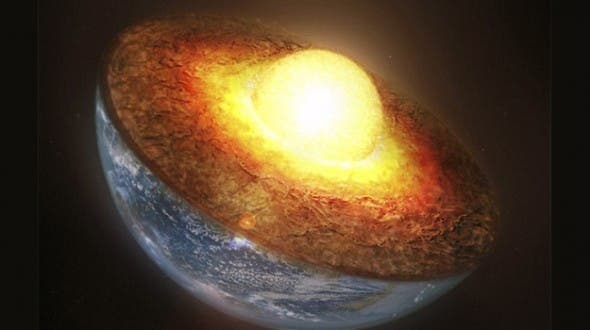
In 1936, Danish seismologist Inge Lehmann performed a groundbreaking study showing that Earth’s iron-rich inner core is solid although it’s hotter than the sun’s surface. Since then, our understanding of the planet’s innermost layer has been constantly refined. Earlier this year, for instance, scientists in Australia showed that the inner core may be made of two distinct layers, which suggests perhaps two separate cooling events in Earth’s history. But that’s not all.
A new potentially textbook-altering study shows that the inner core may not be entirely solid — at least not in the sense that we image a solid material. Instead, scientists have found that the deepest layer of the Earth is made of a tangled bunch of solid surfaces that sit against melted or mushy iron.
Earth sounds more and more like a meat pie

Although the inner core is obscured by more than 4,000 miles (6,300 km) of crust, mantle, and liquid outer core, scientists have a fairly clear picture of what goes inside the bowels of the Earth. How so?
Whenever a volcano erupts or an earthquake strikes, these events generate acoustic waves whose properties, such as direction, angle, and velocity, change predictably depending on the material they encounter.
There are multiple types of seismic waves, ignoring surface waves, which are responsible for the onslaught in the wake of some very powerful earthquakes. When studying the inner layers of Earth, geophysicists mainly focus on primary waves (P-waves) and shear waves (S-waves). P-waves travel through all types of mediums, whereas S-waves only travel through solid materials.
When seismic waves created by earthquakes hit the liquid outer core then travel through the inner core, seismic data gathered from stations across the world record an extra wave going off at right angles which can only be explained by a shear wave. This is how Lehmann showed that the inner core, which is about the size of the moon, is solid. It’s not all that different from how a doctor might use a CT scanner to image what’s inside your body without cutting it open.
Geophysicists are constantly learning new things about Earth’s inner layers as seismic data improves, helped by new tools such as machine learning algorithms and other AI machines. A new study led by Rhett Butler from the University of Hawaiʻi at Mānoa School of Ocean and Earth Science and Technology (SOEST), found that the inner core is not exactly solid. Instead, it’s a melange of liquid, soft, and hard structures. The heterogeneous composition is especially striking in the top 150 miles (240 km) of the inner core.
“In stark contrast to the homogeneous, soft-iron alloys considered in all Earth models of the inner core since the 1970s, our models suggest there are adjacent regions of hard, soft, and liquid or mushy iron alloys in the top 150 miles of the inner core,” said Butler. “This puts new constraints upon the composition, thermal history and evolution of Earth.”
The outer core is entirely liquid and much less controversial, with its molten iron in a constant churning movement, driven by convection as it steadily loses heat from the time Earth formed to the static mantle above. It’s this motion that generates our planet’s magnetic field like a dynamo, which cushions us from harmful radiation from the sun.
However, the outer core is influenced by the inner core. So having a better grasp of its true structure helps scientists form a better understanding of the dynamics between the inner and outer cores.
“Knowledge of this boundary condition from seismology may enable better, predictive models of the geomagnetic field which shields and protects life on our planet,” said Butler.
The findings appeared in the journal Science Advances.


